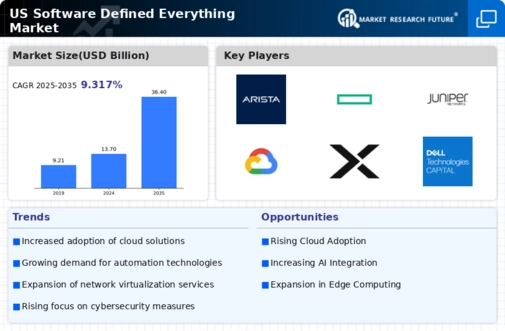The software defined-everything market is currently characterized by intense competition and rapid innovation, driven by the increasing demand for flexible and scalable IT solutions. Major players such as Microsoft (US), Amazon (US), and IBM (US) are at the forefront, each adopting distinct strategies to enhance their market positioning. Microsoft (US) focuses on integrating AI capabilities into its software-defined solutions, thereby enhancing user experience and operational efficiency. Amazon (US), through its AWS platform, emphasizes cloud-native architectures and services, which are pivotal in driving digital transformation across various sectors. Meanwhile, IBM (US) is concentrating on hybrid cloud solutions, aiming to provide businesses with the agility needed to adapt to changing market conditions. Collectively, these strategies contribute to a dynamic competitive environment, where innovation and adaptability are paramount.
Key business tactics within this market include localized manufacturing and supply chain optimization, which are essential for meeting the diverse needs of customers across different regions. The competitive structure appears moderately fragmented, with several key players exerting substantial influence. This fragmentation allows for a variety of solutions and services, catering to a wide range of customer requirements. However, the presence of dominant players like Microsoft (US) and Amazon (US) suggests a trend towards consolidation, as these companies seek to expand their market share through strategic partnerships and acquisitions.
In October 2025, Microsoft (US) announced a significant partnership with a leading telecommunications provider to enhance its cloud services, aiming to improve connectivity and service delivery for enterprise customers. This move is strategically important as it not only broadens Microsoft's service offerings but also strengthens its position in the competitive landscape by leveraging the telecommunications provider's infrastructure. Such partnerships are likely to enhance customer trust and satisfaction, which are critical in retaining market share.
In September 2025, Amazon (US) unveiled a new suite of AI-driven tools within its AWS platform, designed to streamline operations for businesses transitioning to cloud environments. This initiative underscores Amazon's commitment to innovation and positions it as a leader in providing cutting-edge solutions that meet the evolving needs of its clients. The introduction of these tools may significantly enhance operational efficiencies for businesses, thereby solidifying Amazon's competitive edge in the market.
In August 2025, IBM (US) launched a new hybrid cloud solution that integrates advanced security features, catering to the growing demand for secure data management. This strategic action reflects IBM's focus on addressing customer concerns regarding data privacy and security, which are increasingly critical in today's digital landscape. By prioritizing security in its offerings, IBM is likely to attract a broader customer base, particularly in sectors where data protection is paramount.
As of November 2025, current trends in the software defined-everything market include a pronounced shift towards digitalization, sustainability, and the integration of AI technologies. Strategic alliances are increasingly shaping the competitive landscape, enabling companies to leverage complementary strengths and enhance their service offerings. Looking ahead, competitive differentiation is expected to evolve, with a greater emphasis on innovation and technology rather than solely on price. Companies that can reliably optimize their supply chains while delivering innovative solutions are likely to emerge as leaders in this rapidly changing market.

















Leave a Comment